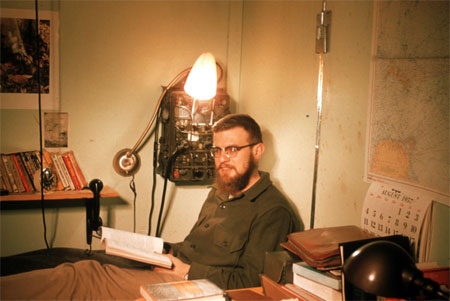Wealth of experienceAmerican Polar Society meeting attracts veteran scientists, explorersPosted June 4, 2010
Centuries? A thousand years? It was hard to estimate the wealth of polar experience gathered in the small auditorium on the University of Colorado at Boulder One thing was for sure: This had to be one of the most unique meetings of Antarctic and Arctic scientists and explorers in recent history. Brought together by the venerable American Polar Society Among the attendees were people like Robert Dodson, who served as an assistant geologist and sled dog handler during the 1947-48 Ronne Antarctic Research Expedition. Led by the famously mercurial Finn Ronne, a Norwegian-American explorer, the expedition had included the first two women to winter in Antarctica — Edith Ronne, who died last year, and Jennie Darlington, wife of pilot Harry Darlington and still a friend of Dodson’s all these years later. John Behrendt was definitely not a friend of Finn Ronne, who was the unpopular leader of Ellsworth Station during the winter of 1957 when Behrendt was a young scientist taking part in the International Geophysical Year (IGY) Behrendt also presented one of the nearly 20 talks over the two-day conference about the first efforts to determine the size of the Antarctic ice sheet in the 1950s and 1960s. That work laid the foundation for today’s more sophisticated measurements of the ice sheets and their possible contribution to future sea-level rise. The 78-year-old scientist noted that while the technology has changed, so has the spirit of Antarctic research. “It’s not as much fun as in the old days,” Behrendt said, admitting a certain bias. “Maybe something is lost. There’s still a need for exploration.” Geographic and scientific explorations were certainly the major themes of the meeting — but certainly not mutually exclusive. Charles Bentley and Richard Cameron, fellow IGY scientists who participated in tractor train traverses across East Antarctica in the 1960s, mixed tales of science and adventure when recounting the early days of Antarctic research. [See previous article: Practically home.] The long hauls across virgin territory were exciting and surreal, according to Cameron. At the South Pole of Inaccessibility — the point most distant from any coast on the continent — the American researchers found the remains of a Soviet-era research base, complete with a plastic bust of Vladimir Lenin, a seminal leader of the communist nation. “This was the spot I always though of as the place where your in-laws can’t get a hold of you,” Cameron quipped of the cold and remote location on the high polar plateau. Sophisticated airborne radar eventually killed the overland traverse at the end of the 1960s, according to Bentley. However, the tractor trains are back in vogue, both for research and hauling cargo and fuel. One of the modern pioneers of the overland traverse, John Wright, spoke on the four-year trial and error of blazing a trail for the U.S. Antarctic Program “You can’t see the crevasses. It’s as flat as Kansas,” said Wright, who led the proof-of-concept traverse that ended on Dec. 23, 2006 at the South Pole. Today, the 1,000-mile-long route has become part of the USAP’s regular operations, offsetting the use of more than 40 LC-130 flights and reducing the program’s carbon footprint. The meeting also included its share of polar groupies — people with an intense interest in the polar regions — and book authors and aspiring book authors like Leilani Henry. Henry’s father, George Gibbs Jr., is widely believed to have been the first African-American to set foot on the continent as a Navy sailor during a 1939-1941 expedition led by Adm. Richard Byrd. It seemed that just about everyone had a polar story to tell, even if he or she wasn’t on the official schedule. Long-time friends Robert Flint and Dale Vance spoke about their experiences as American scientists participating in an exchange program with the Soviet Union that sent both men to the Russian Vostok Station at different times in their Antarctic careers. Despite the decades that have lapsed since he was at Vostok and U.S. stations like Byrd in the 1960s and 1970s, Vance said his affinity for Antarctica hasn’t dimmed. “It wasn’t a job. It was an adventure,” he said.
TransPolar LLC
|



For USAP Participants |
For The Public |
For Researchers and EducatorsContact UsNational Science FoundationOffice of Polar Programs Geosciences Directorate 2415 Eisenhower Avenue, Suite W7100 Alexandria, VA 22314 Sign up for the NSF Office of Polar Programs newsletter and events. Feedback Form |





